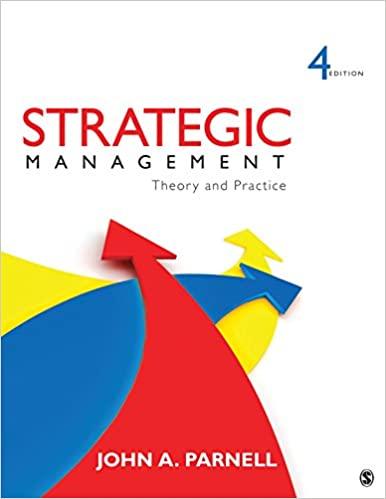Answered step by step
Verified Expert Solution
Question
1 Approved Answer
The below factors are needed Resources Capabilities Core Competencies -Walt Disney, Wall Street Journal, Feb. 4, 1958 In December 2012, Walt Disney Company Chairman and
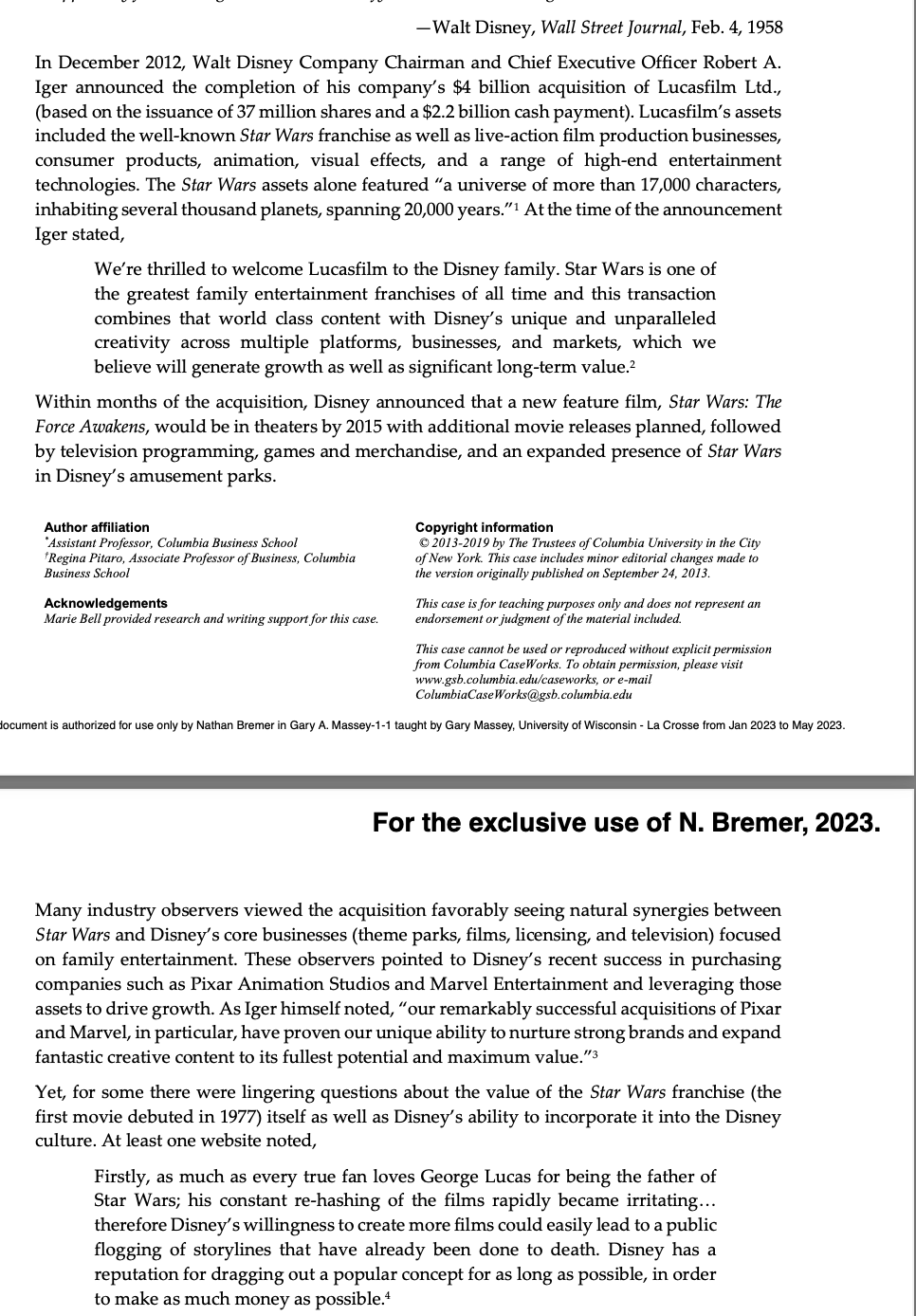
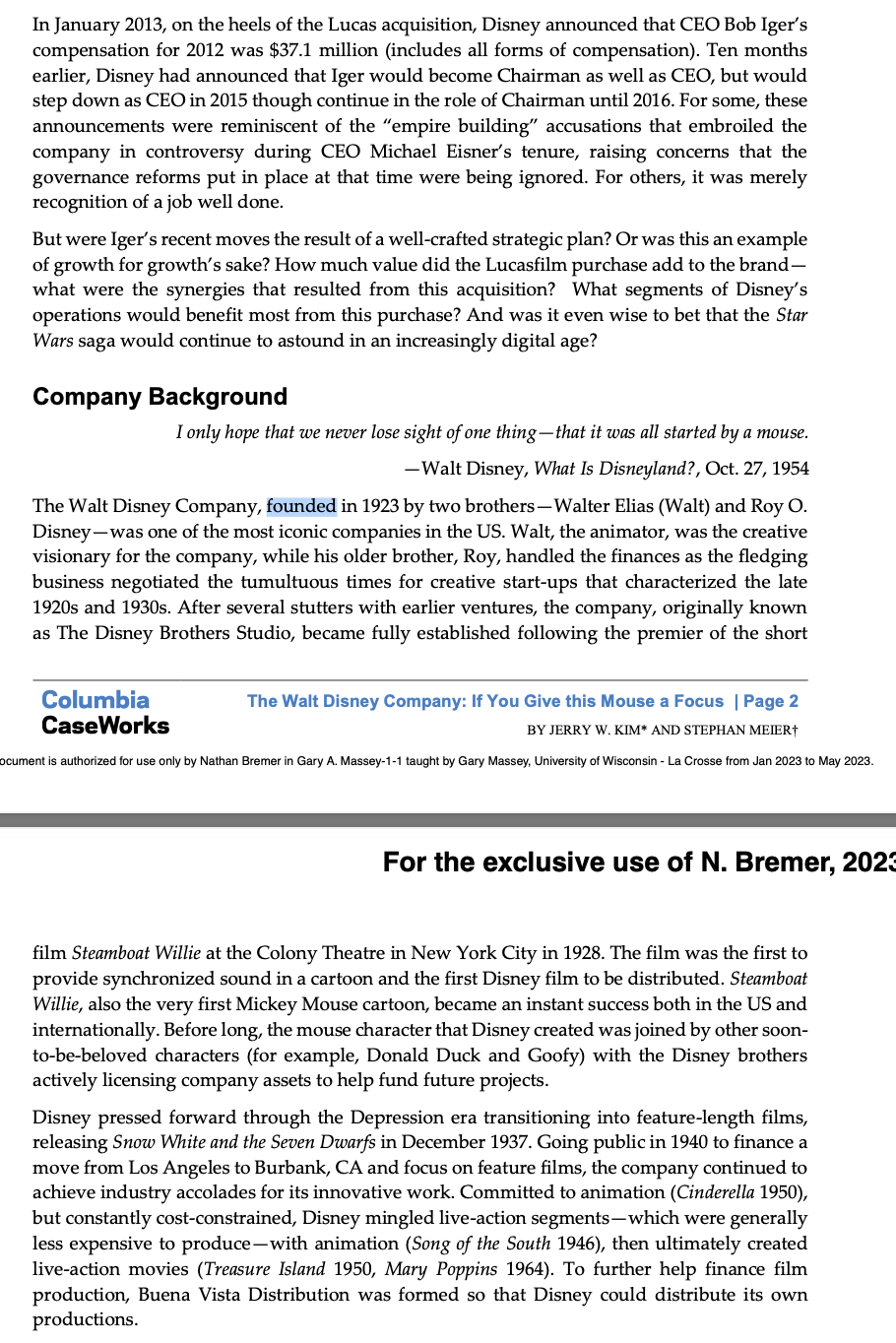
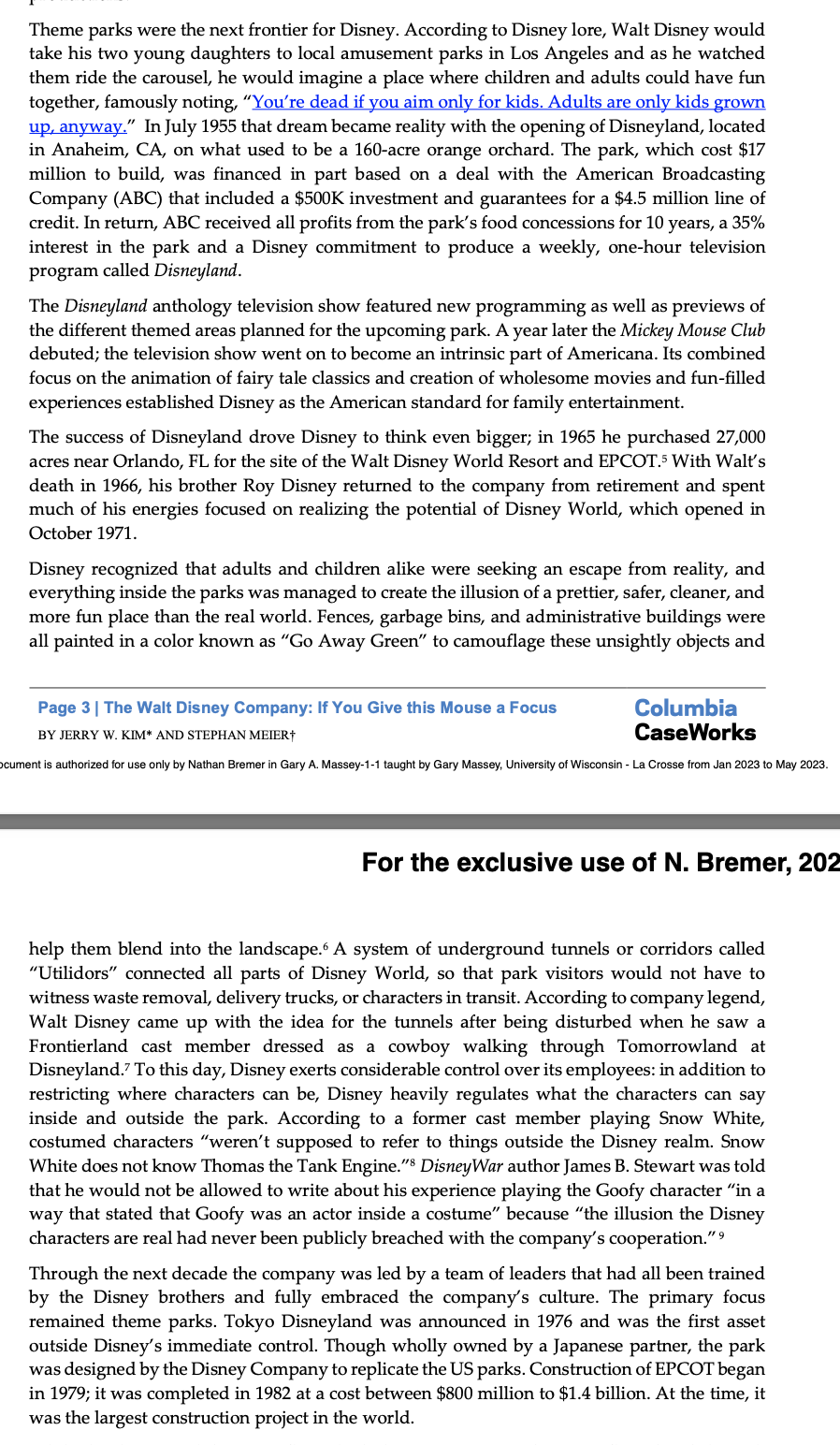
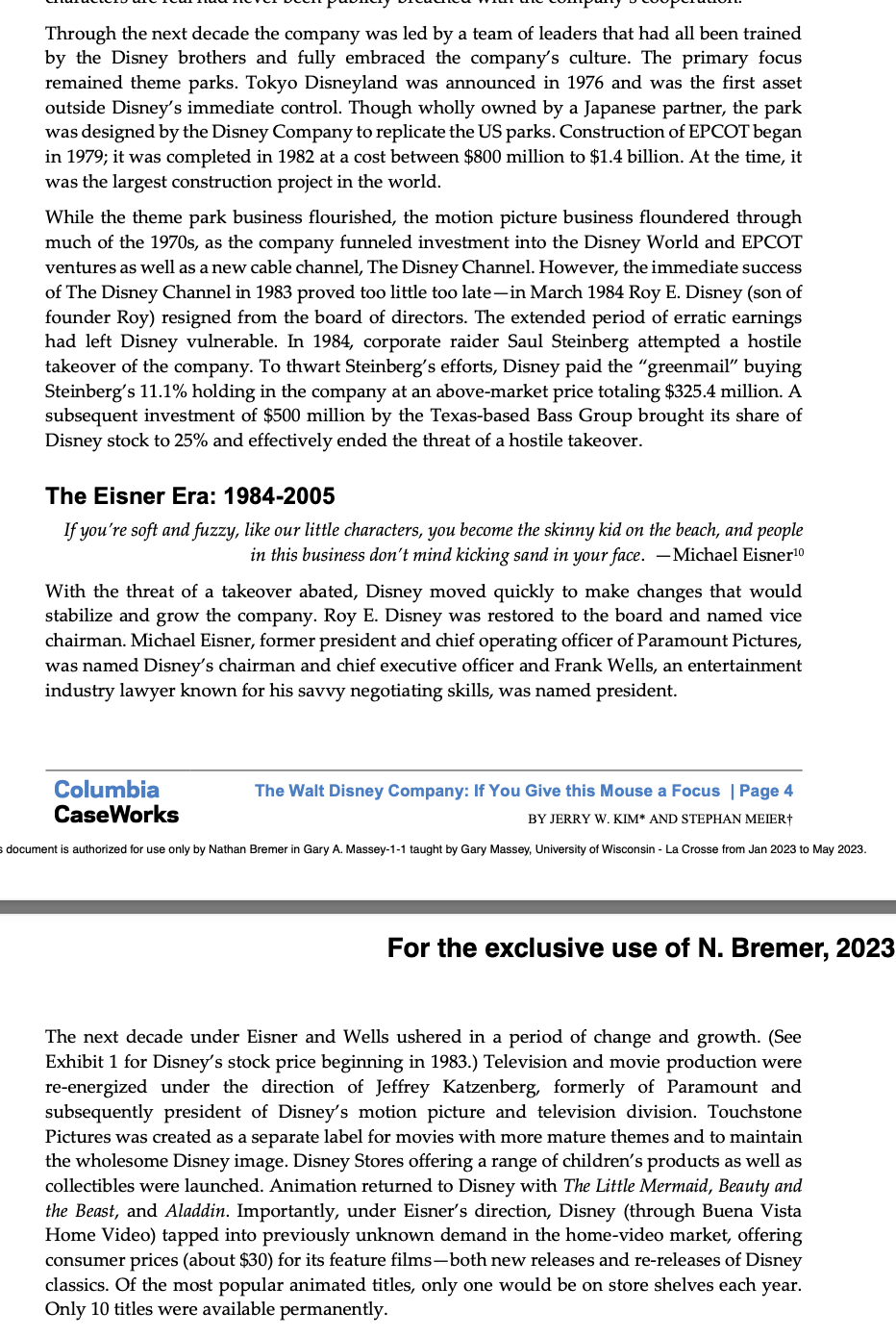


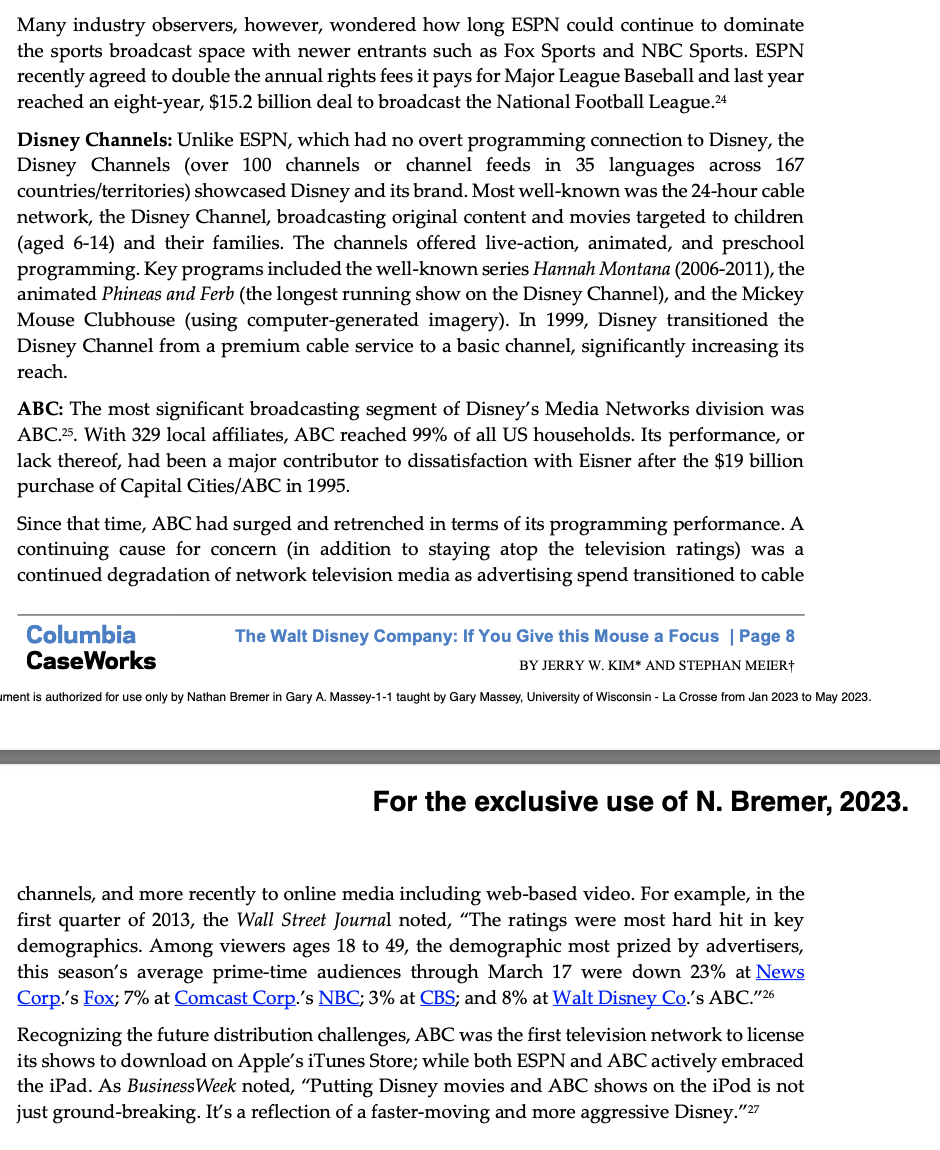
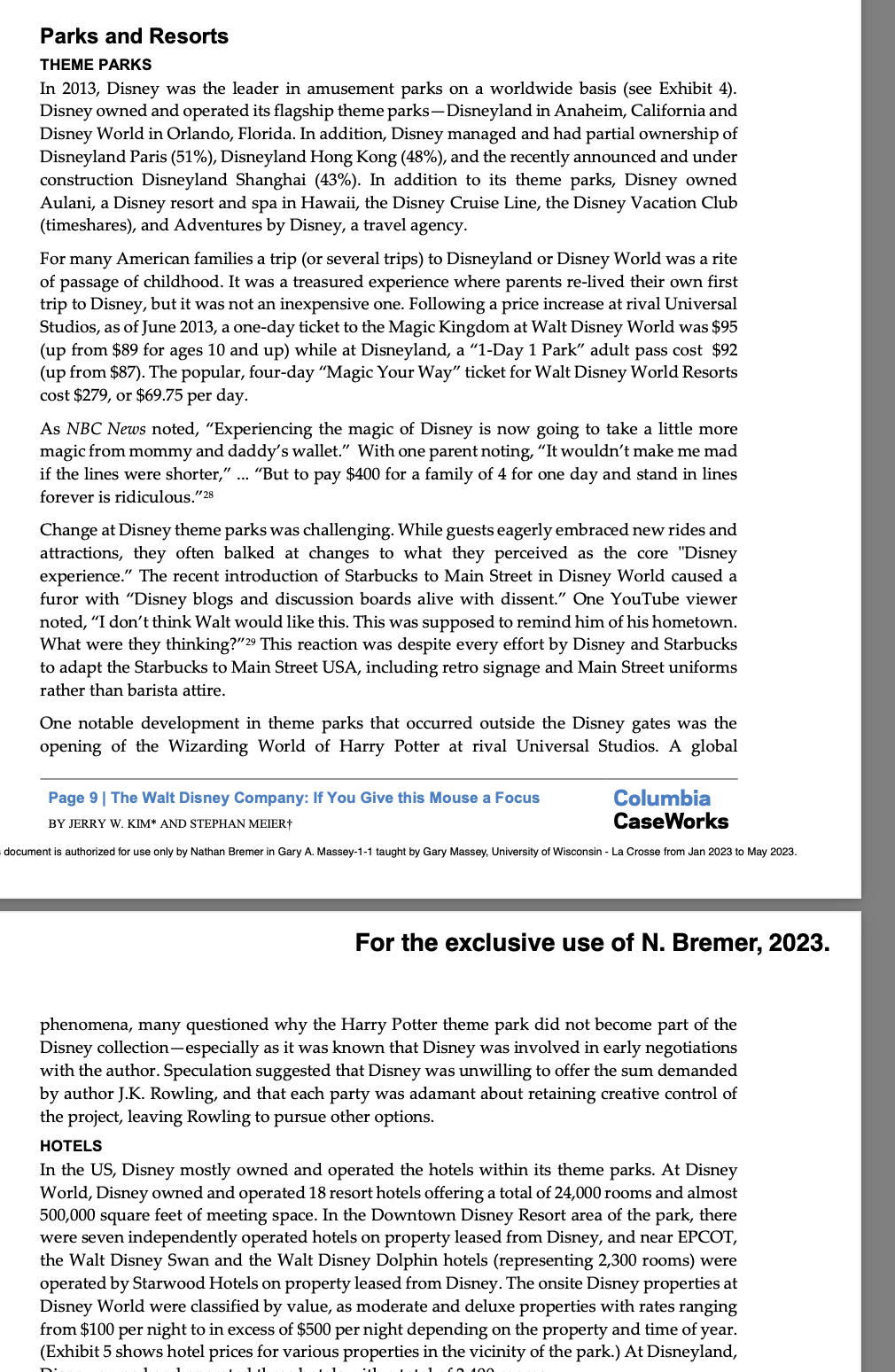
The below factors are needed
Resources
Capabilities
Core Competencies
-Walt Disney, Wall Street Journal, Feb. 4, 1958 In December 2012, Walt Disney Company Chairman and Chief Executive Officer Robert A. Iger announced the completion of his company's $4 billion acquisition of Lucasfilm Ltd., (based on the issuance of 37 million shares and a $2.2 billion cash payment). Lucasfilm's assets included the well-known Star Wars franchise as well as live-action film production businesses, consumer products, animation, visual effects, and a range of high-end entertainment technologies. The Star Wars assets alone featured "a universe of more than 17,000 characters, inhabiting several thousand planets, spanning 20,000 years." 1 At the time of the announcement Iger stated, We're thrilled to welcome Lucasfilm to the Disney family. Star Wars is one of the greatest family entertainment franchises of all time and this transaction combines that world class content with Disney's unique and unparalleled creativity across multiple platforms, businesses, and markets, which we believe will generate growth as well as significant long-term value. 2 Within months of the acquisition, Disney announced that a new feature film, Star Wars: The Force Awakens, would be in theaters by 2015 with additional movie releases planned, followed by television programming, games and merchandise, and an expanded presence of Star Wars in Disney's amusement parks. cument is authorized for use only by Nathan Bremer in Gary A. Massey-1-1 taught by Gary Massey, University of Wisconsin - La Crosse from Jan 2023 to May 2 For the exclusive use of N. Bremer, 2 Many industry observers viewed the acquisition favorably seeing natural synergies between Star Wars and Disney's core businesses (theme parks, films, licensing, and television) focused on family entertainment. These observers pointed to Disney's recent success in purchasing companies such as Pixar Animation Studios and Marvel Entertainment and leveraging those assets to drive growth. As Iger himself noted, "our remarkably successful acquisitions of Pixar and Marvel, in particular, have proven our unique ability to nurture strong brands and expand fantastic creative content to its fullest potential and maximum value." 3 Yet, for some there were lingering questions about the value of the Star Wars franchise (the first movie debuted in 1977) itself as well as Disney's ability to incorporate it into the Disney culture. At least one website noted, Firstly, as much as every true fan loves George Lucas for being the father of Star Wars; his constant re-hashing of the films rapidly became irritating... therefore Disney's willingness to create more films could easily lead to a public flogging of storylines that have already been done to death. Disney has a reputation for dragging out a popular concept for as long as possible, in order to make as much money as possible. 4 In January 2013, on the heels of the Lucas acquisition, Disney announced that CEO Bob Iger's compensation for 2012 was $37.1 million (includes all forms of compensation). Ten months earlier, Disney had announced that Iger would become Chairman as well as CEO, but would step down as CEO in 2015 though continue in the role of Chairman until 2016. For some, these announcements were reminiscent of the "empire building" accusations that embroiled the company in controversy during CEO Michael Eisner's tenure, raising concerns that the governance reforms put in place at that time were being ignored. For others, it was merely recognition of a job well done. But were Iger's recent moves the result of a well-crafted strategic plan? Or was this an example of growth for growth's sake? How much value did the Lucasfilm purchase add to the brandwhat were the synergies that resulted from this acquisition? What segments of Disney's operations would benefit most from this purchase? And was it even wise to bet that the Star Wars saga would continue to astound in an increasingly digital age? Company Background I only hope that we never lose sight of one thing - that it was all started by a mouse. -Walt Disney, What Is Disneyland?, Oct. 27, 1954 The Walt Disney Company, founded in 1923 by two brothers - Walter Elias (Walt) and Roy O. Disney-was one of the most iconic companies in the US. Walt, the animator, was the creative visionary for the company, while his older brother, Roy, handled the finances as the fledging business negotiated the tumultuous times for creative start-ups that characterized the late 1920s and 1930s. After several stutters with earlier ventures, the company, originally known as The Disney Brothers Studio, became fully established following the premier of the short Columbia The Walt Disney Company: If You Give this Mouse a Focus | Page 2 Case Works BY JERRY W. KIM* AND STEPHAN MEIER iment is authorized for use only by Nathan Bremer in Gary A. Massey-1-1 taught by Gary Massey, University of Wisconsin - La Crosse from Jan 2023 to May For the exclusive use of N. Bremer, film Steamboat Willie at the Colony Theatre in New York City in 1928. The film was the first to provide synchronized sound in a cartoon and the first Disney film to be distributed. Steamboat Willie, also the very first Mickey Mouse cartoon, became an instant success both in the US and internationally. Before long, the mouse character that Disney created was joined by other soonto-be-beloved characters (for example, Donald Duck and Goofy) with the Disney brothers actively licensing company assets to help fund future projects. Disney pressed forward through the Depression era transitioning into feature-length films, releasing Snow White and the Seven Dwarfs in December 1937. Going public in 1940 to finance a move from Los Angeles to Burbank, CA and focus on feature films, the company continued to achieve industry accolades for its innovative work. Committed to animation (Cinderella 1950), but constantly cost-constrained, Disney mingled live-action segments-which were generally less expensive to produce-with animation (Song of the South 1946), then ultimately created live-action movies (Treasure Island 1950, Mary Poppins 1964). To further help finance film production, Buena Vista Distribution was formed so that Disney could distribute its own productions. Theme parks were the next frontier for Disney. According to Disney lore, Walt Disney would take his two young daughters to local amusement parks in Los Angeles and as he watched them ride the carousel, he would imagine a place where children and adults could have fun together, famously noting, " You're dead if you aim only for kids. Adults are only kids grown up, anyway." In July 1955 that dream became reality with the opening of Disneyland, located in Anaheim, CA, on what used to be a 160-acre orange orchard. The park, which cost $17 million to build, was financed in part based on a deal with the American Broadcasting Company ( ABC ) that included a $500K investment and guarantees for a $4.5 million line of credit. In return, ABC received all profits from the park's food concessions for 10 years, a 35% interest in the park and a Disney commitment to produce a weekly, one-hour television program called Disneyland. The Disneyland anthology television show featured new programming as well as previews of the different themed areas planned for the upcoming park. A year later the Mickey Mouse Club debuted; the television show went on to become an intrinsic part of Americana. Its combined focus on the animation of fairy tale classics and creation of wholesome movies and fun-filled experiences established Disney as the American standard for family entertainment. The success of Disneyland drove Disney to think even bigger; in 1965 he purchased 27,000 acres near Orlando, FL for the site of the Walt Disney World Resort and EPCOT. 5 With Walt's death in 1966, his brother Roy Disney returned to the company from retirement and spent much of his energies focused on realizing the potential of Disney World, which opened in October 1971. Disney recognized that adults and children alike were seeking an escape from reality, and everything inside the parks was managed to create the illusion of a prettier, safer, cleaner, and more fun place than the real world. Fences, garbage bins, and administrative buildings were all painted in a color known as "Go Away Green" to camouflage these unsightly objects and Page3TheWaltDisneyCompany:IfYouGivethisMouseaFocusBYJERRYW.KIMANDSTEPHANMEIERColumbiaCaseWorks iument is authorized for use only by Nathan Bremer in Gary A. Massey-1-1 taught by Gary Massey, University of Wisconsin - La Crosse from Jan 2023 to May 202 For the exclusive use of N. Bremer, 2( help them blend into the landscape. 6 A system of underground tunnels or corridors called "Utilidors" connected all parts of Disney World, so that park visitors would not have to witness waste removal, delivery trucks, or characters in transit. According to company legend, Walt Disney came up with the idea for the tunnels after being disturbed when he saw a Frontierland cast member dressed as a cowboy walking through Tomorrowland at Disneyland. 7 To this day, Disney exerts considerable control over its employees: in addition to restricting where characters can be, Disney heavily regulates what the characters can say inside and outside the park. According to a former cast member playing Snow White, costumed characters "weren't supposed to refer to things outside the Disney realm. Snow White does not know Thomas the Tank Engine."8 DisneyWar author James B. Stewart was told that he would not be allowed to write about his experience playing the Goofy character "in a way that stated that Goofy was an actor inside a costume" because "the illusion the Disney characters are real had never been publicly breached with the company's cooperation." 9 Through the next decade the company was led by a team of leaders that had all been trained by the Disney brothers and fully embraced the company's culture. The primary focus remained theme parks. Tokyo Disneyland was announced in 1976 and was the first asset outside Disney's immediate control. Though wholly owned by a Japanese partner, the park was designed by the Disney Company to replicate the US parks. Construction of EPCOT began in 1979; it was completed in 1982 at a cost between $800 million to $1.4 billion. At the time, it was the largest construction project in the world. Through the next decade the company was led by a team of leaders that had all been trained by the Disney brothers and fully embraced the company's culture. The primary focus remained theme parks. Tokyo Disneyland was announced in 1976 and was the first asset outside Disney's immediate control. Though wholly owned by a Japanese partner, the park was designed by the Disney Company to replicate the US parks. Construction of EPCOT began in 1979; it was completed in 1982 at a cost between $800 million to $1.4 billion. At the time, it was the largest construction project in the world. While the theme park business flourished, the motion picture business floundered through much of the 1970s, as the company funneled investment into the Disney World and EPCOT ventures as well as a new cable channel, The Disney Channel. However, the immediate success of The Disney Channel in 1983 proved too little too late-in March 1984 Roy E. Disney (son of founder Roy) resigned from the board of directors. The extended period of erratic earnings had left Disney vulnerable. In 1984, corporate raider Saul Steinberg attempted a hostile takeover of the company. To thwart Steinberg's efforts, Disney paid the "greenmail" buying Steinberg's 11.1% holding in the company at an above-market price totaling $325.4 million. A subsequent investment of $500 million by the Texas-based Bass Group brought its share of Disney stock to 25% and effectively ended the threat of a hostile takeover. The Eisner Era: 1984-2005 If you're soft and fuzzy, like our little characters, you become the skinny kid on the beach, and people in this business don't mind kicking sand in your face. -Michael Eisner 10 With the threat of a takeover abated, Disney moved quickly to make changes that would stabilize and grow the company. Roy E. Disney was restored to the board and named vice chairman. Michael Eisner, former president and chief operating officer of Paramount Pictures, was named Disney's chairman and chief executive officer and Frank Wells, an entertainment industry lawyer known for his savvy negotiating skills, was named president. Columbia The Walt Disney Company: If You Give this Mouse a Focus | Page 4 CaseWorks BY JERRY W. KIM* AND STEPHAN MEIER icument is authorized for use only by Nathan Bremer in Gary A. Massey-1-1 taught by Gary Massey, University of Wisconsin - La Crosse from Jan 2023 to May 20 For the exclusive use of N. Bremer, 2 The next decade under Eisner and Wells ushered in a period of change and growth. (See Exhibit 1 for Disney's stock price beginning in 1983.) Television and movie production were re-energized under the direction of Jeffrey Katzenberg, formerly of Paramount and subsequently president of Disney's motion picture and television division. Touchstone Pictures was created as a separate label for movies with more mature themes and to maintain the wholesome Disney image. Disney Stores offering a range of children's products as well as collectibles were launched. Animation returned to Disney with The Little Mermaid, Beauty and the Beast, and Aladdin. Importantly, under Eisner's direction, Disney (through Buena Vista Home Video) tapped into previously unknown demand in the home-video market, offering consumer prices (about $30 ) for its feature films -both new releases and re-releases of Disney classics. Of the most popular animated titles, only one would be on store shelves each year. Only 10 titles were available permanently. Theme parks that had remained profitable in the downturn were updated and expanded with new attractions. Additional hotels were built; nightlife locations and complementary activities such as water parks were added. Euro Disneyland (later renamed Disneyland Paris) opened in 1992, outside Paris. Disney had a 49% ownership stake, having invested $200 million in the $4.4 billion park. Disney operated the park and received 10% from ticket sales and 5% from merchandise sales regardless of park profitability. As 1993 came to a close, it appeared Disney could do no wrong. The company had acquired a baseball team, the Anaheim Angels, and an NHL hockey team - the Anaheim Ducks-named after the fictional team in the Disney movie The Mighty Ducks. Another venture that offered stage productions of popular Disney movies such as Beauty and the Beast and The Lion King turned profitable in a notoriously fickle industry. Disney invested $25 million in Steve Jobs's struggling Pixar Animation Studios for three movies and distribution rights. Toy Story (1995), Pixar's first film, was the first feature-length, computer-animated film and a tremendous success at the box office. (See Exhibit 2 for the evolution of the Disney portfolio.) However, Disney's run was not to last-the final decade of Eisner's tenure at Disney was marked by tragedy, turmoil, and slumping performance. After Disney President Wells died unexpectedly in 1994, Eisner was named president and chief executive officer. The move created distance between Eisner and Katzenberg, who ultimately left Disney to form DreamWorks SKG (along with Steven Spielberg and David Geffen). Eisner's confrontational management style created increasing tension in the organization. The acquisition of Capital Cities/ABC by Disney in 1995 for $19 billion seemed only to add to the discontent. As the Wall Street Journal noted at the time, "Disney's micromanagement has left many at ABC unhappy and anxious. The congenial atmosphere that once dominated the network's top ranks is gone; in its place is the high-pressure culture of Disney, which often pits executives against each other." 11 Problems for Eisner appeared to creep up at every turn. Disney's Internet business failed to deliver. Tensions between Pixar and Disney also started to mount. Disney and Pixar had forged a 10 year 5 film co-production agreement in 1997, where the two companies would split the costs and profits from box office returns and sales of related products such as home videos, \begin{tabular}{ll} \hline Page 5| The Walt Disney Company: If You Give this Mouse a Focus & Columbia \\ BY JERRY W. KIM* AND STEPHAN MEIER & CaseWorks \end{tabular} ocument is authorized for use only by Nathan Bremer in Gary A. Massey-1-1 taught by Gary Massey, University of Wisconsin - La Crosse from Jan 2023 to May 2023. For the exclusive use of N. Bremer, 202 toys and video games. Disney had exclusive rights to market and distribute the films, as well as ownership of the characters that were developed before and during the agreement. While the partnership had been lucrative for both sides, the continuing success of Pixar films (and foundering of Disney traditional animation movies) led Steve Jobs to seek better terms for the company. The dispute became a personal battle between two high profile CEOs, and in 2004 Pixar declared that it would be "moving on" and seeking a distribution deal with another studio once it completed its 5 film requirement with the release of Cars. 12 Within the theme parks, Disneyland Paris was failing to deliver on its initial promise, and the prospects of ABC television seemed to dim as that network's ratings faltered. In fact, ABC and other acquisitions made by Eisner seemed to be hurting the Disney brand by drawing negative attention to the company. In 1997, the Southern Baptist Convention, the largest Protestant body in the United States, called for a boycott of all Disney products which lasted until 2005 after Ellen DeGeneres, host of the ABC show Ellen, came out as a lesbian. 13 The Catholic League heavily criticized Disney for the Miramax movie "The Priest" (1994), which portrayed gay and drunken priests in a sympathetic light, and successfully pressured Disney into selling the distribution rights for Dogma (1999), a film that depicted angels leading a bloody massacre, and cast controversial pop singer Alanis Morissette as a skeeball-loving God. 14 Governance/Leadership As 2003 dawned, there was a growing discontent with Eisner's leadership of the company. The company's board had been listed for two consecutive years in BusinessWeek's list of Worst Boards. As BusinessWeek noted earlier, For most of the 1990s, Walt Disney Co. occupied a prominent place in BusinessWeek's rankings of America's worst corporate boards. Directors there were long on ties to CEO Michael D. Eisner and short on management expertise. Although performance was strong, oversight was minimal. The company's reaction to this dubious distinction? With its stock climbing and shareholders happy, it more or less ignored the issue, saying only that Disney's strong performance spoke for itself. 15 Between 1998 and 2000 Eisner earned more than $680 million from the exercise of stock options, 16 though many questioned that level of compensation. As Disney's stock faltered, leadership questions grew as did questions about the Board. Eisner had earned a reputation for toughness, with at least one former boss noting, "Michael is competitive... there is an excessiveness that has bothered me. Disney makes deals that are too tough and when a deal's too tough it never works out in the end." 17 Board members' relationships with Eisner raised questions of independence. For example, Reveta Bowers, a board member from 1993-2003, ran the school attended by one of Eisner's sons, while another member was President Emeritus of Georgetown University, "the alma mater of one of Eisner's sons and recipient of more than $1 million from Eisner." 18 In a dramatic move, Roy E. Disney again resigned from the Board, citing several areas of concern including low ratings at ABC, Eisner's abrasive micromanagement style, loss of key Columbia The Walt Disney Company: If You Give this Mouse a Focus | Page 6 CaseWorks BY JERRY W. KIM* AND STEPHAN MEIER ocument is authorized for use only by Nathan Bremer in Gary A. Massey-1-1 taught by Gary Massey, University of Wisconsin - La Crosse from Jan 2023 to May 2 For the exclusive use of N. Bremer, employees, and weakening relationships with key partners including Pixar (Steve Jobs) and Miramax. The following day, Disney's ally on the Board, Stanley Gold, resigned. Gold cited many of the same concerns in his resignation, but also questioned Eisner's compensation package as well as the independence of Disney's board. The resignations were followed in March 2004, by a public non-confidence vote at the Disney annual meeting where 45% of shareholders failed to support Eisner's re-election to the board. Eisner survived the day but soon after relinquished his role as chairman. In September 2005, after fending off a hostile takeover bid by Comcast, Eisner resigned and then-COO Bob Iger was named CEO. At the time, most observers had low expectations of Iger, expecting "more of the same." And Iger was not inheriting a feel-good company culture, as BusinessWeek noted, "Disney [had] lost its animating spirit. To say the culture was poisonous doesn't begin to capture the company's dysfunction." 19 But to the surprise of many close to the company, Iger changed the work environment, reached out to former Disney people for strategic advice, and pushed decisionmaking and execution deeper into the organization. Notably after the Pixar acquisition, Iger gave control of Disney's animation unit to Pixar CEO John Lasseter who became Disney's chief creative officer. Once again Disney was a company on the move, as Iger "upended Eisner's centrally planned company, hacking away at the bureaucracy and unshackling a group of veteran executives to plot their own courses." 20 Many industry observers, however, wondered how long ESPN could continue to dominate the sports broadcast space with newer entrants such as Fox Sports and NBC Sports. ESPN recently agreed to double the annual rights fees it pays for Major League Baseball and last year reached an eight-year, $15.2 billion deal to broadcast the National Football League. 24 Disney Channels: Unlike ESPN, which had no overt programming connection to Disney, the Disney Channels (over 100 channels or channel feeds in 35 languages across 167 countries/territories) showcased Disney and its brand. Most well-known was the 24-hour cable network, the Disney Channel, broadcasting original content and movies targeted to children (aged 6-14) and their families. The channels offered live-action, animated, and preschool programming. Key programs included the well-known series Hannah Montana (2006-2011), the animated Phineas and Ferb (the longest running show on the Disney Channel), and the Mickey Mouse Clubhouse (using computer-generated imagery). In 1999, Disney transitioned the Disney Channel from a premium cable service to a basic channel, significantly increasing its reach. ABC: The most significant broadcasting segment of Disney's Media Networks division was ABC.25. With 329 local affiliates, ABC reached 99% of all US households. Its performance, or lack thereof, had been a major contributor to dissatisfaction with Eisner after the $19 billion purchase of Capital Cities/ABC in 1995. Since that time, ABC had surged and retrenched in terms of its programming performance. A continuing cause for concern (in addition to staying atop the television ratings) was a continued degradation of network television media as advertising spend transitioned to cable Columbia The Walt Disney Company: If You Give this Mouse a Focus | Page 8 CaseWorks BY JERRY W. KIM* AND STEPHAN MEIER ment is authorized for use only by Nathan Bremer in Gary A. Massey-1-1 taught by Gary Massey, University of Wisconsin - La Crosse from Jan 2023 to May 2023. For the exclusive use of N. Bremer, 2023. channels, and more recently to online media including web-based video. For example, in the first quarter of 2013, the Wall Street Journal noted, "The ratings were most hard hit in key demographics. Among viewers ages 18 to 49 , the demographic most prized by advertisers, this season's average prime-time audiences through March 17 were down 23% at News Corp.'s Fox; 7% at Comcast Corp.'s NBC; 3\% at CBS; and 8\% at Walt Disney Co.'s ABC.'"26 Recognizing the future distribution challenges, ABC was the first television network to license its shows to download on Apple's iTunes Store; while both ESPN and ABC actively embraced the iPad. As BusinessWeek noted, "Putting Disney movies and ABC shows on the iPod is not just ground-breaking. It's a reflection of a faster-moving and more aggressive Disney." 27 Parks and Resorts THEME PARKS In 2013, Disney was the leader in amusement parks on a worldwide basis (see Exhibit 4). Disney owned and operated its flagship theme parks-Disneyland in Anaheim, California and Disney World in Orlando, Florida. In addition, Disney managed and had partial ownership of Disneyland Paris (51\%), Disneyland Hong Kong (48\%), and the recently announced and under construction Disneyland Shanghai (43\%). In addition to its theme parks, Disney owned Aulani, a Disney resort and spa in Hawaii, the Disney Cruise Line, the Disney Vacation Club (timeshares), and Adventures by Disney, a travel agency. For many American families a trip (or several trips) to Disneyland or Disney World was a rite of passage of childhood. It was a treasured experience where parents re-lived their own first trip to Disney, but it was not an inexpensive one. Following a price increase at rival Universal Studios, as of June 2013, a one-day ticket to the Magic Kingdom at Walt Disney World was $95 (up from $89 for ages 10 and up) while at Disneyland, a "1-Day 1 Park" adult pass cost $92 (up from $87 ). The popular, four-day "Magic Your Way" ticket for Walt Disney World Resorts cost $279, or $69.75 per day. As NBC News noted, "Experiencing the magic of Disney is now going to take a little more magic from mommy and daddy's wallet." With one parent noting, "It wouldn't make me mad if the lines were shorter," ... "But to pay $400 for a family of 4 for one day and stand in lines forever is ridiculous. 28 Change at Disney theme parks was challenging. While guests eagerly embraced new rides and attractions, they often balked at changes to what they perceived as the core "Disney experience." The recent introduction of Starbucks to Main Street in Disney World caused a furor with "Disney blogs and discussion boards alive with dissent." One YouTube viewer noted, "I don't think Walt would like this. This was supposed to remind him of his hometown. What were they thinking?"29 This reaction was despite every effort by Disney and Starbucks to adapt the Starbucks to Main Street USA, including retro signage and Main Street uniforms rather than barista attire. One notable development in theme parks that occurred outside the Disney gates was the opening of the Wizarding World of Harry Potter at rival Universal Studios. A global Page9|TheWaltDisneyCompany:IfYouGivethisMouseaFocusBYJERRYW.KIM*ANDSTEPHANMEIERColumbiaCaseWorks ument is authorized for use only by Nathan Bremer in Gary A. Massey-1-1 taught by Gary Massey, University of Wisconsin - La Crosse from Jan 2023 to May 2 For the exclusive use of N. Bremer, phenomena, many questioned why the Harry Potter theme park did not become part of the Disney collection-especially as it was known that Disney was involved in early negotiations with the author. Speculation suggested that Disney was unwilling to offer the sum demanded by author J.K. Rowling, and that each party was adamant about retaining creative control of the project, leaving Rowling to pursue other options. HOTELS In the US, Disney mostly owned and operated the hotels within its theme parks. At Disney World, Disney owned and operated 18 resort hotels offering a total of 24,000 rooms and almost 500,000 square feet of meeting space. In the Downtown Disney Resort area of the park, there were seven independently operated hotels on property leased from Disney, and near EPCOT, the Walt Disney Swan and the Walt Disney Dolphin hotels (representing 2,300 rooms) were operated by Starwood Hotels on property leased from Disney. The onsite Disney properties at Disney World were classified by value, as moderate and deluxe properties with rates ranging from $100 per night to in excess of $500 per night depending on the property and time of year. (Exhibit 5 shows hotel prices for various properties in the vicinity of the park.) At DisneylandStep by Step Solution
There are 3 Steps involved in it
Step: 1

Get Instant Access to Expert-Tailored Solutions
See step-by-step solutions with expert insights and AI powered tools for academic success
Step: 2

Step: 3

Ace Your Homework with AI
Get the answers you need in no time with our AI-driven, step-by-step assistance
Get Started


